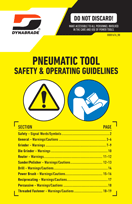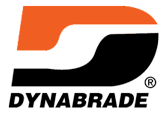Safety
Our Commitment To Your Safety

Dynabrade Inc. recognizes the importance of safety and health to business success and strives to continuously improve performance and be a leader in safety and health. Dynabrade Inc. is committed to the safety and health of all operators and strive to provide a safe and healthy workplace environment. The following content contains guidelines for safety and health best practices.
View Safety GuideGeneral Safety Information
Accessories & Abrasives Safety
Safe Operating Practices For Grinders/Sanders
Machine Specifications & Safety
Machine specifications are believed to be accurate at time of printing. However, due to design changes, exact specifications of current tools may vary from the listed data.It is our policy to test and measure our tools in a ready-to-use condition and to state the test results in industry-accepted terms. Dynabrade measures typical production tools using the recommended air hose size, 90 PSIG air line pressure measured at tool inlet, and all muffling and speed control mechanisms. Compromises to these real-use operating conditions can artificially enhance performance measurements.
For Dynabrade Tool Specifications:
Ergonomics
The Term "Ergonomics" can be Defined as the Study of Work. Ergonomics helps adapt the job to the person, rather than forcing the person to fit the job. Adapting the job to fit the worker can help reduce ergonomic stress and eliminate many potential ergonomic disorders. The objective of ergonomics is to adapt the job and workplace to the worker by designing tasks, work stations, tools and equipment that are within the worker's physical capabilities and limitations.
Egonomics Guide